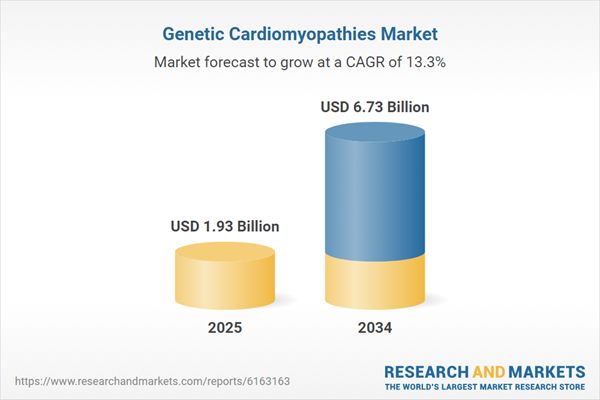Genetic Cardiomyopathies: Introduction
Genetic cardiomyopathy or familial hypertrophic cardiomyopathy is a heart condition that thickening of the cardiac muscle. In this case, the cardiac thickening usually occurs in the muscular wall (interventricular septum) that separates the left ventricle (lower chamber of heart) from right ventricle. Genetic cardiomyopathy may impede the flow of oxygen rich blood from the heart. This in turn, may lead to an abnormal heartbeat (arrhythmias) in the patients.Common symptoms include chest pain, shortness of bread, palpitations, dizziness, or fainting. However, the symptoms differ from person to person, even within the same family. People suffering from genetic cardiomyopathy are at a sudden risk of death, despite having no symptoms.
Genetic Cardiomyopathies Market Analysis
Genetic cardiomyopathy is a commonly inherited cardiac illness, affecting approximately 2-5 in a 1000 people. Non-pharmacological treatments like septal myectomy and alcohol septal ablation are frequently used to improve long-term quality of life in patients suffering from genetic cardiomyopathy. Over the years, significant advancements in the non-invasive and pharmacological treatment have been observed.In 2023, the FDA approved a drug called Mavacamtem, popularly known as Camzyos, as a novel alternative for treating genetic cardiomyopathy. This new class drug, a myosin inhibitor, works by cutting down myosin levels which are present in abundance in the patients.
The genetic cardiomyopathies market value is expected to see a significant hike in the forecast period, with the rising emphasis on using novel techniques to fight the ailment. New study set-ups like induced pluripotent stem cells, three dimensional printing of cells, use of scaffolds and engineered heart tissue, are now being looked upon as a treatment alternative. Moreover, extensive knowledge on mutated proteins, protein quality control, and toxicity has opened new avenue of contemporary techniques like gene editing and repair using CRISPR Cas9, customised drugs and antisense therapies to develop an efficient and accurate treatment for the disease.
With a rising preference for precision medicine, researchers are now combining machine learning guided ECG and imaging analyses to facilitate new targeted drugs. Hence, we can a anticipate a substantial genetic cardiomyopathies market growth in the forecast period.
Genetic Cardiomyopathies Market Segmentation
Genetic Cardiomyopathies Market Report and Forecast 2025-2034 offers a detailed analysis of the market based on the following segments:Market Breakup by Disease Type
- Dilated Cardiomyopathy
- Hypertonic Cardiomyopathy
- Restrictive Cardiomyopathy
- Others
Market Breakup by Drug Type
- Anticoagulants
- Anti-Hypertensives
- Antiarrhytensives
- Cardiac Glycosides
- Others
Market Breakup by Route of Administration
- Oral
- Topical
Market Breakup by End User
- Hospitals
- Clinics
- Ambulatory Services Centres
- Others
Market Breakup by Region-7MM
- United States
- EU-4 and the United Kingdom
- Japan
Genetic Cardiomyopathies Market Overview
Genetic cardiomyopathy is a major cause of heart failure. With the rise in population, obesity, geriatric population, the North American region has been susceptible to number of heart failures, as a result, it has dominated the genetic cardiomyopathies market share in the historic period. Effective measures have been taken the government to mitigate the number of morbidities, which have been successful to an extent. Moreover, the presence of prominent healthcare market players has made a huge impact with regular research and conducting clinical trials to bring the best possible treatment for the patients.In some cases, genetic cardiomyopathy may also lead to heart transplantation. Therefore, the Asian-pacific region can expect a hike in the forecast period, owing to its increasing popularity as medical tourism space. In addition, presence of an aging population is also fuelling investments and government initiatives to develop a quality infrastructure that can drive a prominent research and development in the contemporary treatment alternatives.
Genetic Cardiomyopathies Market: Competitor Landscape
The key features of the market report include patent analysis, grants analysis, clinical trials analysis, funding and investment analysis, partnerships, and collaborations analysis by the leading key players. The major companies in the market are as follows:- Novartis International AG
- Merck & Co.
- Teva Pharmaceuticals
- Mylan N.V
- Bristo Myers Squibb Company
- Boston Scientific Corporation
- Sanofi S.A.
- Becton, Dickinson and Company
- Critical Care Diagnostics Inc.
- Labcorp
This product will be delivered within 3-5 business days.
Table of Contents
Companies Mentioned
- Novartis International AG
- Merck & Co.
- Teva Pharmaceuticals
- Mylan N.V
- Bristo Myers Squibb Company
- Boston Scientific Corporation
- Becton
- Dickinson and Company
- Critical Care Diagnostics Inc.
- Labcorp
Table Information
| Report Attribute | Details |
|---|---|
| No. of Pages | 350 |
| Published | July 2025 |
| Forecast Period | 2025 - 2034 |
| Estimated Market Value ( USD | $ 1.93 Billion |
| Forecasted Market Value ( USD | $ 6.73 Billion |
| Compound Annual Growth Rate | 13.3% |
| Regions Covered | Global |
| No. of Companies Mentioned | 10 |









